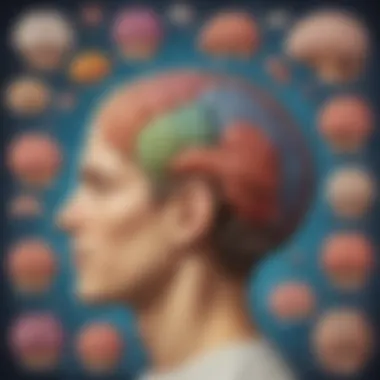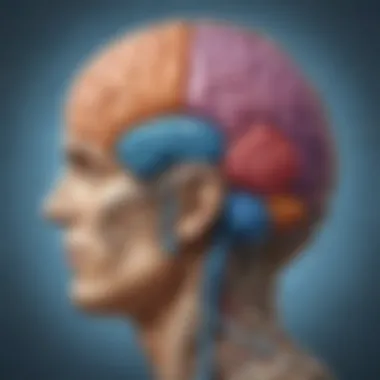Understanding Brain Lateralization: Tests to Determine Dominant Hemisphere


Intro
Brain lateralization involves how different halves of the brain manage various functions. This process is not just scientific jargon; it connects directly to how we learn, create, and solve problems. Understanding if you are left-brained or right-brained can unveil your cognitive preferences. This knowledge has practical implications on education and personal growth.
To get a grasp on this topic, let’s uncover some fun facts, explore different tests available, and understand how these findings can reshuffle approaches to learning and self-improvement.
Science Fun Facts
The study of brain lateralization reveals many intriguing insights about human behavior. Here are some interesting facts:
- Brain Hemispheres: The left hemisphere is often linked to logic and analytical tasks, while the right hemisphere associates with creativity and arts.
- Percentage of Right vs. Left: Studies suggest that about 70% of people can be classified as left-brained or having left-hemisphere dominance. The remaining 30% are either truly right-brained or exhibit traits from both sides.
- Split-Brain Patients: Research with patients who have undergone corpus callosotomy shows fascinating variations in how each hemisphere operates independently.
“Understanding your brain's communication pathway not only aids in educational success but also ensures creativity isn’t stifled.”
Exploring Various Scientific Concepts
Lateralization emphasizes the arrangement of tasks assigned to each hemisphere. Left-handed individuals may not always follow these alignments, sparking curiosity about our unique cognitive arrangements. Recognition of left- and right-brain functions can enhance teaching methods as well as learning strategies.
This topic can be engagingly unpacked through educational videos and animations. Platforms like Britannica.com offer insightful short clips discussing diversified roles of the brain.
Engagement with interactive learning tools can lead both children and adults to a deeper understanding of these functions. For instance, online quizzes can uncover how one might typically solve puzzles, revealing preferences strongly leaning toward one hemisphere.
Discover Your Learning Style
Identifying one's dominant hemisphere entails understanding various tests designed to uncover cognitive tendencies. Some popular assessments ask practical questions related to thinking styles and behavioral tendencies.
Ultimately, knowing your style helps in grasping optimal learning methods, be it hands-on activities for kinesthetic learners or visual aids for spatial individuals.
As we dive deeper into the interactions of both sides of our brain, clarity around individual thinking preferences may evolve, contributing greatly to personal and academic fulfilment.
Enlightenment regarding these concepts serves an useful purpose. Whether through brain quizzes or hands-on learning, delving into this topic undoubtedly opens doors to effective educational strategies.
Getting familiar with one's cognitive wiring supplies confidence and can nurture creativity as result.
Prolusion to Brain Lateralization
Understanding brain lateralization is crucial in uncovering how our brain functions and affects our behaviors. This concept explores the differences between the brain's two hemispheres, particularly how each side may govern distinct cognitive abilities and personality traits. For parents and educators, this insight is valuable in tailoring learning strategies for children. Recognizing whether a child is more right-brained or left-brained can lead to more effective communication and educational methods.
Definition of Brain Lateralization
Brain lateralization refers to the specialized functions performed by the left and right hemispheres of the brain. The left side is usually linked with logical reasoning and analytic skills, while the right side enhances creativity and emotional understanding. This classification highlights variations in thought processes and problem-solving styles adopted by individuals based on they’re hemispheric strengths.
Moreover, it is vital to acknowledge that this division is not absolute. People utilize both hemispheres in their tasks. However, one side may dominate, affecting how they think and learn.
Historical Background
The study of brain lateralization dates back to ancient studies regarding hemisphere functionality. In the modern era, findings from scientists like Roger Sperry have shaped our understanding significantly. Sperry’s split-brain experiments in the 1960s illustrated how patients with severed corpus callosum had distinct behaviors based on hemispheric engagement.
This foundational work initiated interest in how lateralization can influence personality patterns and cognitive abilities. Ongoing research continues to deepen our comprehension of the brain's divided nature. The advent of brain-imaging technology has introduced more intricate observations about which activities engage specific hemispheres, enriching the historical narrative on this complex subject.
"Understanding brain lateralization not only offers a glimpse into our minds but can also influence educational philosophies and personal development approaches."
Overall, brain lateralization presents implications that extend into various domains, from learning and creativity to engineering logical thinking.
Characteristics of Right-Brained Individuals
Understanding the characteristics of right-brained individuals provides valuable insights into cognitive styles and creative tendencies. Right-brained thinkers primarily process information holistically rather than logically. They tend to enjoy activities that require imagination, intuition, and emotional connection. This section delves into the distinct properties associated with right-brained dominance, particularly in terms of their cognitive styles and the influence they have on creativity and emotional expression.


Cognitive Styles and Learning
Right-brained individuals often have unique cognitive styles that distinguish them from their left-brained counterparts. They are inclined to grasp the big picture before focusing on specifics. Learning for these individuals usually thrives in environments enriched with visual aids, group collaborations, and innovative problem-solving tasks.
Key traits of right-brained learners include:
- Preference for visual learning, such as diagrams and videos.
- Strong ability to think divergently, suggesting different approaches to problem-solving.
- Tendency to learn through hands-on experience rather than rote memorization.
This cognitive style can impact academic performance and influence choices about educational paths. Thier curiosity and enjoyment of new experiences drive them to explore assorted domains. This openness fosters creative thinking, which is often unbound by strict methodological frameworks. For parents and educators, recognizing these traits is essential in providing tailored learning strategies that cultivate and boost this potential.
Creativity and Emotional Expression
Creativity is perhaps one of the most pronounced traits among right-brained individuals. They possess an intuitive understanding of beauty and an ability to express emotions through various forms of art, music, or writing. Accessible channels allow for idedyation, inspiring both themselves and those around them. Right-brained people tend to:
- Generate original ideas effortlessly, often leaping from one concept to another.
- Find joy and fulilmnet in expressing feelings, sometimes via non-verbal communicaiton.
- Use their imaginative prowess to approach challenges in a unique way, integrating emotional intelligence with their creativity.
In context of emotional expression, their deep sensitivity often translates into empathy which can enrich personal and professional relationships. Innovative projects, discussions, or expressing oneself through artistic endeavors provide meaningful outlets for right-brained dominants. This characteristic comes with advantages in fields that value originality, potentially guiding career decisions. Hence, comprehending the profound connections between creativity and emotional expression sheds light on nurturing those elements in individual lives.
The cognitive habits of right-brained individuals foster an enriching perspective on problem-solving and art, benefitting personal identity development greatly.
Characteristics of Left-Brained Individuals
Understanding the characteristics of left-brained individuals offers valuable insights into how cognitive preferences mold learning styles and problem-solving abilities. The left hemisphere of the brain is primarily associated with analytical skills, logic, and a methodical approach toward tasks. These traits influence various aspects of an individual’s life including education, personal relationships, and career paths.
Analytical Thinking and Logical Reasoning
Analytical thinking is a crucial skill for left-brained individuals. This cognitive style emphasizes breaking down complex problems into smaller, manageable parts. Through this method, people can scrutinize each component, evaluate information critically, and derive logical conclusions. This systematic way of thinking is not only vital for academic success, but also plays an important role in decision-making processes.
Logical reasoning complements analytical thinking by providing a structured approach to deducing facts. Left-brained individuals often excel in subjects like mathematics, science, and logic-based puzzles. They are capable of engaging in critical thinking, which ensures thorough arguments and cohesive debates during discussions. In environments that require problem-solving skills, such as workplaces or academic classrooms, these individuals often emerge as reliable leaders who provide clear, strategic direction.
- Benefits of analytical thinking include:
- Improved problem-solving abilities
- Enhanced capability to identify patterns
- Strong planning and organization skills
Understanding these traits emphasizes the significance of promoting environments that nurture analytical thought. For students, leaning towards left-brained methodologies can lead to strategies that enable better understanding of subjects that demand logic and reasoning.
Verbal Skills and Structure
Verbal skills are yet another defining aspect of left-brained individuals. Their language processing abilities enable them to articulate thoughts effectively, whether in spoken or written form. Left-brained individuals often produce well-structured essays and reports. They may find it comfortable to engage in discussions that require precision in wording and a clear conveyance of messages.
A structured approach to communication also leads to better retention of information. This is particularly important during educational pursuits or in professional situations where clarity is critical. Left-brained individuals tend to appreciate clear guidelines, rules, and frameworks in their learning environments.
- Key features of left-brained verbal skills include:
- Clarity in written and spoken communication
- Ability to follow detailed instructions
- Preference for structured information rather than abstract explanations
Emphasizing these capabilities helps educators and caregivers recognize the inherent strengths of left-brained learners. Utilizing structured lessons, clear instructions, and logical sequencing within teaching methods can maximize their potential and engagement.
Left-brained individuals demonstrate how essential analytical and verbal skills are for shaping thoughtful, strategic thinkers in various aspects of academics and life.
Importance of Understanding Your Brain Hemisphere Preference
Understanding brain hemisphere preference is vital for individuals wishing to maximize their potential in both learning environments and professional settings. Knowing whether one is predominantly left-brained or right-brained offers significant insight that can influence one's methods of acquiring knowledge and their approach to achieving personal goals.
When individuals understand which hemisphere they align with more strongly, they can tailor their studying techniques. For example, right-brained learners thrive in environments that emphasize visual aids and creativity, while left-brained learners benefit from linear reasoning and structured frameworks. Knowing this informs educators and parents about the most effective ways to teach content. Instead of applying a 'one-size-fits-all' method, teaching techniques can be adapted to correspond with individual learning styles, fostering a deeper comprehension.
It is equally important to recognize how understanding brain lateralization can impact career paths. Individuals who are aware of their cognitive strengths can gravitate toward professions that require their highest skills. For instance, someone with a left-brain dominance might excel in fields like law or engineering, which demand organized reasoning. On the contrary, someone dominated by right-brain thinking could find fulfillment in domains such as art or psychotherapy, where creativity and empathy are paramount. This awareness can lead to greater job satisfaction and more productive work environments.
The knowledge of one's brain hemisphere preference serves as a powerful tool, enabling informed decisions about educational pathways and career choices.


In summary, recognizing brain lateralization enhances the learning and career experiences of individuals. It empowers them to make informed decisions based on a clear understanding of their natural tendencies. As education becomes increasingly individualized, leveraging this knowledge can provide practical benefits, aiding people in taking actionable steps toward fulfilling their capabilities.
Understanding brain hemisphere preference isn't merely academic; it's practical and applicable for life skill development.
Tests to Determine if You Are Right or Left Brained
Understanding brain lateralization requires knowing your cognitive styles. Brain dominance tests are essential for analyzing individuals' strengths, weaknesses, and preferences. These assessments help you see how your brain tends to process information, affecting learning styles, career paths, and interpersonal relationships.
Standardized Brain Tests
Standardized brain tests offer an objective measurement of brain lateralization. These tests have established protocols and often involve a series of cognitive tasks designed to assess specific abilities linked to each hemisphere. Examples of these tests include the Dichotic Listening Task and the Block Design Test. The Dichotic Listening Task requires the participant to listen to different sounds presented to each ear. Results can indicate which side processes information more efficiently. In contrast, the Block Design Test is more related to spatial abilities and may show left hemisphere advantages in analytical tasks while demonstrating right hemisphere strengths in holistic processing.
Taking standardized tests allows you to gain reliable data but can have limitations too. The context of the test might not fully represent the individual’s everyday cognitive functioning.
Self-Assessment Tools
Self-assessment tools provide a more personal approach in determining brain dominance. Often online, these quizzes ask questions about preferences in decision-making, creativity, and thought processes. Such tools may include the Myers-Briggs Type Indicator and casual quizzes found on various educational platforms. They are more accessible and can be fun to take for many individuals.
The results depend strongly on self-perception, which can be both an advantage and a disadvantage. You could reveal insights into your behaviors honestly, that standardized tests may not show, but the subjective nature might lead to bias in your insights. It is essential to take these tools in context as they serve as a starting point rather than the ultimate answer.
Interpretation of Test Results
Once tests are complete, interpreting the results is crucial. Valid understanding allows you to integrate brain dominance theories into real-world circumstances, enhancing personal or educational growth. For example, if standardized tests indicate strong right-brain characteristics, you may find that your creativity shines, particularly in settings where innovation matters. Conversely, a left-brain dominance could lead toward proficiency in math or reading.
When analyzing self-assessment results, it is important not to view the outcomes as absolute. The diverse ways individuals think and react are not strictly limited to left or right dominance; many factors influence cognitive orientation.
Understanding your brain preferences is a tool for improvement, not a box to fit into.
By considering various tests and their results, individuals can better grasp their cognitive dynamics. This comprehension allows not for grading but better fitting one's education and career to how one naturally thinks.
Common Misconceptions About Brain Lateralization
Understanding brain lateralization requires addressing the misconceptions surrounding it. These myths often lead to an oversimplified view of our cognitive abilities. By dissecting these misunderstandings, individuals can gain a clearer picture of how their brains actually work. This knowledge is crucial for applying brain lateralization insights effectively in daily life, specifically in learning and personal development.
The Myth of Exclusivity
One of the most common myths about brain lateralization is the idea that individuals are strictly right-brained or left-brained. Many believe that one's characteristics are determined by which hemisphere is dominant. This notion, however, is overly simplistic and not supported by the latest scientific research.
In reality, both hemispheres of the brain work together in a complex manner. Right-brained tendencies, such as creativity and intuition, can be found in people who might use logical reasoning prominently. Conversely, those who excel in analytical tasks may also have a rich, creative side.
It's crucial to recognize that brain lateralization is not a binary trait. Education and personal growth can benefit from understanding that skills lie on a spectrum. Acknowledging both strengths supports a more holistic approach to learning and growth.
Cognitive Flexibility
Cognitive flexibility refers to the mental ability to switch between thinking about different concepts or to think about multiple concepts simultaneously. It is a key aspect of effective problem-solving and adapting to new information.
Promoting cognitive flexibility challenges the traditional view of adhering to solely left or right-brain thinking styles. Research indicates that a healthy balance between both hemispheres supports adaptability, creativity, and effective communication.
For example, a student who engages in diverse learning strategies can enhance their cognitive flexibility. This balanced approach to learning enables them to connect multiple dots and apply knowledge across various domains.
This understanding resists the confines of traditional categorization, embracing a broader spectrum of capabilities. Therefore, fostering cognitive flexibility is essential for overall growth, as it allows the brain to integrate skills for more comprehensive problem-solving capabilities.
Thus, embracing the shared and collaborative nature of both hemispheres opens doors to improved cognitive processing, regardless of dominant traits.
Real-World Applications of Brain Dominance Testing
Understanding brain dominance can help in two vital areas: education and workplace environments. The dominant hemisphere of the brain influences various skills such as problem-solving, creative thinking, and social interactions. By acknowledging these differences, we can adapt our strategies to enhance performance and satisfaction both in learning and professional settings.
Educational Strategies


Applying brain dominance knowledge in education can revolutionize how parents and educators approach teaching. Tailoring educational content to the student's dominant hemisphere can improve engagement and achievement. For instance,
- Right-brained students often benefit from hands-on learning and visual aids, supporting their creative processes.
- Left-brained students may thrive in structured learning with logical approaches and clear instructions.
Incorporating these strategies:
- Use visual storytelling or art projects for creative expression in classes heavy in narrative content.
- Provide logical, step-driven instruction for subjects like math.
These approaches cater to diverse learning styles in classrooms, ensuring that both creative and analytical students receive optimal support.
Workplace Dynamics
In adulthood, recognizing an individual's brain dominance can significantly impact teamwork and productivity. For example, right-brained individuals may excel in roles requiring creativity, such as marketing or design, where innovation is key. On the other hand, left-brained colleagues may perform better in analytical jobs that necessitate critical thinking, such as engineering or data analysis.
Key ideas to strengthen workplace dynamics include:
- Team Composition: Form diverse teams that harness both approaches. Collaboration between right and left-brained individuals can yield powerful results.
- Communication Styles: Awareness of how different mindsets process information can lead to more effective communication strategies, reducing misunderstandings.
Utilizing knowledge of brain hemispheres in corporate training and team development offers immense potential. By embracing the strengths of all members, organizations can cultivate an environment that thrives on diversity and creativity.
Recognizing one's brain dominance can enhance not only personal learning and work enjoyment but also form an invaluable resource for productivity and teamwork.
Further Research Directions in Brain Lateralization
Research on brain lateralization is crucial for several reasons. Understanding how the brain functions can impact the development of educational materials, therapeutic approaches, and cognitive enhancement strategies. Delving into innovative research avenues helps build a more extensive knowledge base in neuroscience and provides insights into how lateralization can enhance personal growth and adaptability.
In this exploration, two primary areas stand out that greatly benefit from continued investigation: neuroscientific advances and interdisciplinary approaches.
Neuroscientific Advances
Neuroscientific research has made tremendous strides in understanding how the brain's hemispheres operate. With recent technological advancements, tools like functional magnetic resonance imaging (fMRI) and electroencephalograms (EEG) allow scientists to observe brain activities and connectivity in real time. These methods have opened pathways to assessing functional symmetries and asymmetries between the left and right hemispheres.
Key points to consider in this segment include:
- Localization of Functions: Determining how specific functions are distributed across hemispheres can clarify tasks like language processing and emotion regulation.
- Neural Plasticity: Investigating whether enhanced brain lateralization can influence neural connectivity and adaptability across lifetimes is important. Individuals could potentially harness this knowledge for better learning strategies or rehabilitation following brain injuries.
- Correlation with Mental Health: Research might uncover how left or right dominance relates to specific mental health conditions. For instance, it may show whether depression or anxiety might be linked to such preferences.
Understanding that the brain is not purely left or right can lead to better therapeutic models that cater to individual needs.
Interdisciplinary Approaches
The study of brain lateralization can greatly benefit from interdisciplinary collaboration. Bringing together experts from diverse fields can generate fresh perspectives on existing research and practical applications. Relevant disciplines include psychology, linguistics, education, and artificial intelligence.
Here are some notable considerations for interdisciplinary approaches:
- Psychological Insights: Examining emotional and cognitive reasons behind hemisphere dominance can help devise tailored educational strategies.
- Adaptive Learning Technologies: Combining neuroscience with computer science could lead to propositions for adaptive learning systems personalized based on brain dominance assessments.
- Social Implications: Incorporating sociological perspectives can enhance understanding of how brain preferences shape interpersonal interactions, cognition, and even cultural norms.
Closure
The conclusion of this article brings together the essential elements regarding brain lateralization and its implications. Understanding how our brain functions, whether predominantly through the right or the left hemisphere, informs us about our learning preferences, creativity, and cognition.
Summary of Key Points
In this exploration, we discussed key aspects:
- Definition and Historical Background: Brain lateralization defines the specialization of certain mental processes in one hemisphere over the other, a notion traced back to various studies in neuroscience.
- Characteristics of Right and Left-Brained Individuals: Right-brained individuals may show higher tendencies toward creativity and emotional depth, while left-brained individuals often excel in analytical reasoning and language skills.
- Importance of Understanding Dominance: Being aware of one's dominant hemisphere can impact educational strategies and professional choices, guiding individuals to optimize their potential.
- Testing Methods: Both standardized tests and self-assessment tools help in determining an individual’s brain hemisphere preference. Learning to interpret these results is vital for personal development.
- Misconceptions and Applications: While many hold misconceptions about strict hemispheric divides, the reality encompasses cognitive flexibility and adaptations relevant across various real-world contexts, such as education and the workplace.
Understanding your brain's functions opens new avenues for personal and professional growth.
Implications for Personal Growth
Ultimately, insights from brain lateralization tests underscore how we can leverage our cognitive strengths. For instance:
- Individuals can tailor their learning approaches. Right-brained learners may benefit from more hands-on or visual methods. Left-brained learners might find structured tutorials more beneficial.
- Career paths can align with cognitive strengths. Fields requiring creativity, such as art or counselling, might attract right-brained individuals. Contrariwise, left-brainers might gravitate toward roles in law, science, and technology.
- Emotional understanding and empathy can enhance collaboration and interpersonal relations when one understands their tendencies in thought processes.
As awareness grows about how our brains function, individuals are better equipped to navigate their world. Understanding brain dominance is not merely academic; it equips everyone, from children to caregiving parents, with ways to nurture growth in one's own developmental journey.







